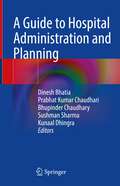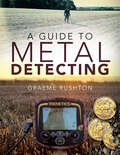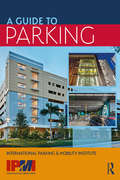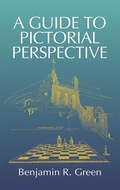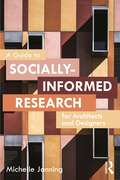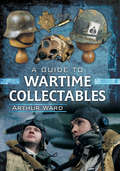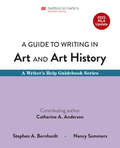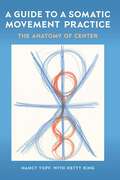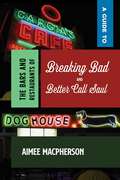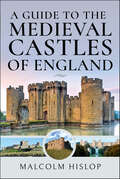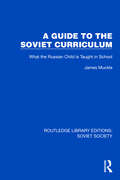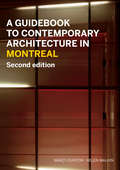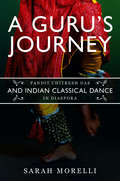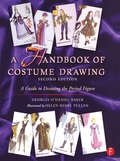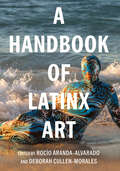- Table View
- List View
A Guide to Hospital Administration and Planning
by Prabhat Kumar Chaudhari Dinesh Bhatia Bhupinder Chaudhary Sushman Sharma Kunaal DhingraThis book is a compilation of work by experts from the different domains of the healthcare industry, ranging from hospital planning to quality management, clinical services to disaster management.Healthcare organizations, being diverse, sensitive, and intricate, warrant thorough and flawless planning. The structure should be not only operationally efficient but also safe for its occupants and visitors. It starts with a brief introduction of the healthcare sector at different levels. It also attempts to justify how the changing healthcare landscape paved the way for establishing a contemporary and ever-evolving specialty of Hospital planning and designing, which is dynamic and frequently requires continuous improvements and updates.Clinical and non-clinical departments have been separately classified in this book, and their respective standards and guidelines have been incorporated while describing the planning concepts. Critical areas of a hospital such as ICU, CCU have been detailed precisely as the operational requirements and level of different sophistication required. A chapter on security aspects and disaster management has also been thoroughly envisioned based on the current scenario at the global level. Issues and management of Hospital Acquired Infection are explained in different chapters based on its relevance and application in that particular area.
A Guide to Impact Fees and Housing Affordability
by Arthur C. Nelson Liza K. Bowles James C. Nicholas Craig Anthony Arnold Julian C. Juergensmeyer Dwight MerriamImpact fees are one-time charges that are applied to new residential developments by local governments that are seeking funds to pay for the construction or expansion of public facilities, such as water and sewer systems, schools, libraries, and parks and recreation facilities. In the face of taxpayer revolts against increases in property taxes, impact fees are used increasingly by local governments throughout the U.S. to finance construction or improvement of their infrastructure. Recent estimates suggest that 60 percent of all American cities with over 25,000 residents use some form of impact fees. In California, it is estimated that 90 percent of such cities impose impact fees. For more than thirty years, impact fees have been calculated based on proportionate share of the cost of the infrastructure improvements that are to be funded by the fees. However, neither laws nor courts have ensured that fees charged to new homes are themselves proportionate. For example, the impact fee may be the same for every home in a new development, even when homes vary widely in size and selling price. Data shows, however, that smaller and less costly homes have fewer people living in them and thus less impact on facilities than larger homes. This use of a flat impact fee for all residential units disproportionately affects lower-income residents.The purpose of this guidebook is to help practitioners design impact fees that are equitable. It demonstrates exactly how a fair impact fee program can be designed and implemented. In addition, it includes information on the history of impact fees, discusses alternatives to impact fees, and summarizes state legislation that can influence the design of local fee programs.This book should be the first place planning professionals, public officials, land use lawyers, developers, homebuilders, and citizen activists turn for help in crafting (or recrafting) proportionate-share impact fee programs.
A Guide to Manga, Anime and Video Game Cosplay
by Holly SwinyardDo you find yourself sat at home wishing you could be in your favorite video game? Or dream of a time when you pretended you were Sailor Moon? Or do you want to embody your Dungeons and Dragons character for real? What’s holding you back? Maybe you need to introduced to cosplay! Cosplay is a phenomenon that is taking over the world. If you haven’t seen it yet, have you not been looking at social media? Cosplay is a mix of exciting craft skills, heady escapism and passion for pop culture that lets you be whoever you want, whenever you want. Cosplay has made its way into TV shows and documentaries, been included as part of film premieres and video game launches, it’s even referenced in the comics, manga and media it comes from! Talk about meta. But what is this super popular hobby? Well, pick up this book, and it’s twin A Guide to Movie and TV Cosplay, to get all the answers. Because it’s more than just dressing up, promise. With a little bit of help from this handy, dandy guide to cosplay, you can get stuck in. Learn about the history of the hobby (it’s been around longer than you’d think!), where it came from and how it got to be the way it is now, get your head around making and designing costumes, find out how about all the amazing skills people are using to make these costumes, and perhaps even try a few yourself. Who knows, you might be rocking out as Astro Boy, Chris Redfield or All Might at the next big comic con! So why not give it a try and play make believe for a day.
A Guide to Metal Detecting
by Graeme RushtonThe aim of this book is to provide detailed information, practical help, handy hints and tips in regards to all aspects of Metal Detecting. By offering advice and guidance this book aims to make the hobby of using a metal detector fun, interesting and interactive to anyone who wishes to have a go! It will give the reader an insight into following best practice and how to enjoy the hobby in a responsible way, everything will be covered from choosing the right detector & equipment to gaining permission to search land, understanding the law and of course giving the necessary information to make sure that people enjoy their hobby to its maximum potential. From beaches to farmland we want you to be able to feel confident enough to search these types of environments and make interesting discoveries without feeling out of your depth. Information will be passed over regarding potential discoveries of treasure and the law surrounding such finds and also the identification of coins and artefacts that the reader may come across in their adventures. After reading this book, you will be able to enjoy this magical and captivating past-time and have the confidence to unearth some fascinating and historical discoveries.
A Guide to Movie Based Video Games, 1982–2000
by Christopher CartonExplore two decades of licensed video games based on blockbuster movies! You’ve seen the movie, now PLAY the movie! Long before gaming came to the big screen, cinema arrived in the homes of millions in the form of licensed video games; playable merchandise that tied in to some of the major tentpoles of cinematic history. Many of these games followed the storylines of the movies on which they were based, as well as providing supplementary adventures to major franchises. Collected in this book are some of the biggest games to come from Hollywood adventures during the '80s and '90s. In this comprehensive book, you’ll find over 300 games across 18 chapters, with sections dedicated to major movie franchises such as Star Wars, Jurassic Park, Top Gun, Pixar, Aliens and Indiana Jones, along with nearly 200 full-color screenshots of major releases. Showcasing the highs and lows of early computer gaming through the 16-bit era and onto the advent of 3D console gaming, A Guide to Movie Based Video Games: 1982 - 2000 covers two decades of video games with trivia, analysis and recommendations. Grab your controller, step into the silver screen and get ready to play!
A Guide to New Mexico Film Locations: From Billy the Kid to Breaking Bad and Beyond
by Jason StrykowskiA Guide to New Mexico Film Locations offers a &“call sheet&” to explore many of the Land of Enchantment&’s most iconic film locales, such as those from Easy Rider or Terminator Salvation. From alpine forests to sand dunes, from spaceports to historic ranches, New Mexico&’s movie backdrops showcase the most dramatic and stunning parts of the state. Using this book as a guide, cinephiles, movie buffs, tourists, producers, New Mexico locals, and armchair explorers can retrace the steps of silver-screen cowboys, superheroes, aliens, and outlaws.Author Jason Strykowski showcases fifty spectacular destinations in this guide including White Sands National Park, the Cumbres & Toltec Scenic Railroad, the Albuquerque Rail Yards, Ski Santa Fe, Carlsbad Caverns National Park, and much, much more. He further gives a glimpse into the many eateries, bars, and hotels where film crews spend their time and offers recommendations for outdoor adventures, indoor shopping, and family-friendly places to play. With plenty of insider tips, this unique guide will inspire readers to experience New Mexico&’s picturesque film locations beyond the screen.Featured Films Include:The Grapes of WrathEasy RiderIndiana Jones and the Last CrusadeCowboys & AliensTerminator SalvationThorWild HogsCrazy HeartLone SurvivorNatural Born KillersContactThe Men Who Stare at Goatsand more . . .
A Guide to Parking
by International Parking InstituteIf you own a car, use public transportation, go to work or school, use health care, shop or dine out, or are part of a metropolitan community, parking affects you, probably in more ways than you’ve thought about. Because parking has such a huge effect on what happens in cities and towns and how the greater transportation system functions, decision-makers are beginning to realize that it’s critical to employ parking expertise at the beginning of the planning process. Designing and implementing an effective, professionally managed parking strategy can mean the difference between frustrating and costly traffic congestion and efficient, time-saving traffic flow. A Guide to Parking provides information on the current state of parking, providing professionals and students with an overview on major areas of parking and the transportation and mobility industry, punctuated by brief program examples.
A Guide to Pictorial Perspective
by Benjamin R. GreenMeeting the challenge of realistic drawing involves the application of science to an individual design sense. Here is a clear, jargon-free primer on recreating objects from nature by using perspective techniques. Author Benjamin R. Green's straightforward approach teaches artists and students at all levels how to visually rationalize the differences between form and appearance.Green begins with definitions of lines (parallel, perpendicular, inclined, horizontal, and vertical) and discussions of the seat of the eye and the vanishing point. He examines the relative situation of the spectator and the object to be drawn, compares parallel and oblique views, and discusses drawing objects with more than four sides and curved-line objects such as arches. Numerous illustrations appear throughout the text.
A Guide to Planning for Community Character
by Lane H. KendigA Guide to Planning for Community Character adds a wealth of practical applications to the framework that Lane Kendig describes in his previous book, Community Character. The purpose of the earlier book is to give citizens and planners a systematic way of thinking about the attributes of their communities and a common language to use for planning and zoning in a consistent and reliable way. This follow-up volume addresses actual design in the three general classes of communities in Kendig's framework-urban, suburban, and rural. The author's practical approaches enable designers to create communities "with the character that citizens actually want." Kendig also provides a guide for incorporating community character into a comprehensive plan. In addition, this book shows how to use community character in planning and zoning as a way of making communities more sustainable. All examples in the volume are designed to meet real-world challenges. They show how to design a community so that the desired character is actually achieved in the built result. The book also provides useful tools for analyzing or measuring relevant design features. Together, the books provide a comprehensive treatment of community character, offering both a tested theory of planning based on visual and physical character and practical ways to plan and measure communities. The strength of this comprehensive approach is that it is ultimately less rigid and more adaptable than many recent "flexible" zoning codes.
A Guide to Socially-Informed Research for Architects and Designers
by Michelle JanningThis book offers an efficient set of step-by-step tips and overarching lessons about how to gather useful, meaningful, and socially-informed data about clients’ and other stakeholders' experiences in architecture and interior design professions. In this guide, author Michelle Janning helps the design professional conduct ongoing evaluation of design projects, create useful pre- and post-design evaluations, frame effective questions for improved future design, involve various stakeholders in the research process, and focus on responsible and evidence-based human-centered design to improve the relationship between design and people’s experiences. Examining a variety of both large- and small-scale project examples from different institutional realms, including healthcare sites, schools, residences, eating establishments, museums, and theaters, this book highlights not only the overlap in these types of projects but also the differences between project sizes that may impact the methods used in any given project. It also offers tools for how to communicate design success to audiences that include potential clients, occupants, and other designers. A Guide to Socially-Informed Research for Architects and Designers is a go-to reference for design professionals interested in using accessible social scientific methods to gather essential and practical information from people who occupy the spaces they design and to do so in an ethical, inclusive, and socially-informed way in order to enhance social sustainability in the built environment.
A Guide to Video Game Movies
by Christopher CartonHave you ever wondered if that game you love was made into a movie? Flip this book open and find out! Explore the fascinating journey of your favorite video games as they make their way to the silver screen! This comprehensive guide contains information on over forty big-screen adaptations of popular video games, including the histories of the series that inspired them. Covering four decades of movies, readers can learn about some of the most infamous movies in video game history, with genres such as horror, martial arts, comedy and children’s animation ensuring there’s plenty of trivia and analysis to keep gamers hooked. With nearly two-hundred full color stills, posters and screenshots, the book is a go-to guide to discovering facts about some of the biggest box office hits and the most disappointing critical bombs in history. From bizarre science fiction like Super Mario Bros. to the latest big budget releases like Monster Hunter, and dozens in between, A Guide to Video Game Movies should please film buffs and die-hard game fans alike. Whether you’re looking for rousing blockbuster action, family-friendly entertainment or a late-night B-movie to laugh at with your friends, you’re bound to find a movie to fit your taste. Put down your controller and grab your popcorn!
A Guide to Wartime Collectables: An Enthusiast's Guide To Militaria
by Arthur WardMake sure you&’re getting the genuine article with this &“well-illustrated&” guide and &“must read&” for collectors of twentieth-century military memorabilia (Antiques Diary). Written by a longtime collector, A Guide to Wartime Collectables tells readers what to look for when looking for authentic military items. From army badges to gas masks, this book covers the major types of twentieth-century military collectables. Arthur Ward shows what these items look like and what new collectors should be looking for to ensure they&’re purchasing authentic artifacts and not reproductions. This book also includes photographs of the author&’s collection that feature important details such as insignias and other regalia. &“A very useful book written by an author who knows his stuff.&” —The Armourer
A Guide to Web Development Using Adobe® Dreamweaver® CS5, with Fireworks® CS5 and Flash® CS5
by Jan MarrelliA Guide to Web Development Using AdobeA(R) Dreamweaver CS5 teaches Flash Fireworks and Dreamweaver in a full-color format. Students learn about Web development HTML CSS and how to use Dreamweaver to create websites. Each chapter discusses concepts which are then reinforced within hands-on activiesAll explanations problems and answers have been produced using Dreamweaver CS5 Fireworks CS5 and Flash CS5. Students are introduced to the history terminology and concepts of networks and the Internet. Email protocol and careers associated with web development are also discussed.
A Guide to Writing in Art and Art History with 2021 MLA Update: A Writer's Help Guidebook Series
by Nancy Sommers Stephen A. BernhardtThis ebook has been updated to provide you with the latest guidance on documenting sources in MLA style and follows the guidelines set forth in the MLA Handbook, 9th edition (April 2021).A Guide to Writing in Art and Art History, part of the Writer’s Help Guidebook Series, offers writing and research support for students writing in the discipline. This compact yet comprehensive guidebook provides the value students want with the essential instruction they need to complete writing tasks successfully. Students will find advice on how to think, read, research, and design and write papers and projects like an art professional.
A Guide to a Somatic Movement Practice: The Anatomy of Center
by Nancy TopfAn introduction to embodied movement through the work of a dance education pioneer In this introduction to the work of somatic dance education pioneer Nancy Topf (1942–1998), readers are ushered on a journey to explore the movement of the body through a close awareness of anatomical form and function. Making available the full text of Topf’s The Anatomy of Center for the first time in print, this guide helps professionals, teachers, and students of all levels integrate embodied, somatic practices within contexts of dance, physical education and therapy, health, and mental well-being. Hetty King, a movement educator certified in the Topf Technique®, explains how the ideas in this work grew out of Topf’s involvement in developing Anatomical Release Technique—an important concept in contemporary dance—and the influence of earlier innovators Barbara Clark and Mabel Elsworth Todd, founder of the approach to movement known as “ideokinesis.” Featuring lessons written as a dialogue between teacher, student, and elements of the body, Topf’s material is accompanied by twenty-one activities that allow readers to use the book as a self-guided manual. A Guide to a Somatic Movement Practice is a widely applicable entry point into the tradition of experiential anatomy and its mindful centering of the living, breathing body.
A Guide to the Bars and Restaurants of Breaking Bad and Better Call Saul
by Aimee MacphersonA toast to curly fries, hot dogs, and hard-shell tacos, Aimee Macpherson’s guide to the bars and restaurants of Breaking Bad and Better Call Saul celebrates the critically acclaimed shows’ fusion of Albuquerque’s real and imagined food and drink.The restaurants and bars featured in Macpherson’s compendium show us glimpses of Walter White’s and Jimmy McGill’s Albuquerque. From the Dog House to Savoy Bar and Grill, from Tuco’s Hideout to Los Pollos Hermanos and every pit stop in between, Macpherson takes us on a tour of the Duke City’s dreamscape of edible artifacts, connecting us to the on-screen heroes and villains we love and admire. Show by show, season by season, Macpherson reveals how restaurants and bars undergo hours of painstaking transformations before appearing on the small screen. Colorful photography and descriptions of the food and drink accompany Macpherson’s insider show analysis. While this book can’t give you the taste of Mike’s pimento cheese sandwich, it does deliver a flavor of the city that has been a main character in this successful franchise from the time Walter White first broke bad in 2008.So, leave the fancy restaurants to New York, ignore the juicing in LA, forget your Paleo diet, and come and taste Albuquerque. Savor the luscious fare of these small-screen giants as you take in the hot sun, the high altitude, and the Duke City’s local grub.
A Guide to the Medieval Castles of England
by Malcolm HislopThis is a well illustrated expert guide to the castles of England, providing concise accounts of what remains to be seen at each site. Spread across the medieval kingdom of England in a network of often formidable strongholds, castles, like cathedrals, are defining landmarks of their age, dominating their settings, in many cases even to this day. By representing an essential aspect of our history and heritage, the interpretation of which is constantly being revised, they demonstrate the value of Malcolm Hislop’s compact, authoritative and well illustrated new guide to English castles. The gazetteer includes an astonishing variety of types, sizes and designs. Individual entries bring out the salient points of interest including historical context, building history and architectural character. The defensive and domestic purposes of these remarkable buildings are explained, as is the way in which their layout and role developed over the course of hundreds of years, from the predominantly earth and timber fortresses of the Normans to the complex stone castles of the later Middle Ages, many of which can be visited today. Hislop’s experience as an archaeologist specializing in medieval buildings, castles in particular, as well as his eye for structural detail, ensure that his guide is a necessary handbook for readers who are keen on medieval history and warfare, and for visitors who are looking for an accessible introduction to these monumental relics of England’s military past.
A Guide to the Soviet Curriculum: What the Russian Child is Taught in School (Routledge Library Editions: Soviet Society)
by James MuckleA Guide to the Soviet Curriculum (1988) surveys the syllabuses for schoolchildren in the Soviet education system following the reforms of 1984. Every subject in the common timetable is covered, and teaching methods, hopes for the future and continuing controversies are discussed. All this is set in the broader context of curriculum philosophy and of the social and moral purposes of Soviet education; the implicit or ‘hidden’ curriculum is also considered.
A Guidebook to Contemporary Architecture in Montreal: Updated and Expanded Second Edition
by Helen Malkin Nancy DuntonA new edition of the popular 2008 guidebook, with updates to the previous entries and 25 new buildings added, that will have the readers exploring all of Montreal.
A Guru’s Journey: Pandit Chitresh Das and Indian Classical Dance in Diaspora (Music in American Life)
by Sarah MorelliAn important modern exponent of Asian dance, Pandit Chitresh Das brought kathak to the United States in 1970. The North Indian classical dance has since become an important art form within the greater Indian diaspora. Yet its adoption outside of India raises questions about what happens to artistic practices when we separate them from their broader cultural contexts. A Guru's Journey provides an ethnographic study of the dance form in the San Francisco Bay Area community formed by Das. Sarah Morelli, a kathak dancer and one of Das's former students, investigates issues in teaching, learning, and performance that developed around Das during his time in the United States. In modifying kathak's form and teaching for Western students, Das negotiates questions of Indianness and non-Indianness, gender, identity, and race. Morelli lays out these issues for readers with the goal of deepening their knowledge of kathak aesthetics, technique, and theory. She also shares the intricacies of footwork, facial expression in storytelling, and other aspects of kathak while tying them to the cultural issues that inform the dance.
A Handbook of Anatomy for Art Students (Dover Anatomy For Artists Ser.)
by Arthur ThomsonSkeletal structure, muscles, heads, special features. Exhaustive text, anatomical figures, undraped photos. Male and female. 337 illustrations.
A Handbook of Costume Drawing: A Guide to Drawing the Period Figure for Costume Design Students
by Georgia BakerPerfect for students of costume design and history, A Handbook of Costume Drawing illustrates and describes the dominant male and female costume silhouettes for major historical periods ranging from Egyptian dynasties through the 1960s. Important details, including head and footwear, hair styles, fashion accessories, shoulders, waist, hem, and neckline are provided to maximize the historical accuracy of each design and to help you fully recreate the look and feel of each period.
A Handbook of Latinx Art (Documents of Twentieth-Century Art)
by RocíO Aranda-Alvarado and Deborah Cullen-MoralesA curated selection of key texts and artists’ voices exploring US Latinx art and art history from the 1960s to the present. A Handbook of Latinx Art is the first anthology to explore the rich, deep, and often overlooked contributions that Latinx artists have made to art in the United States. Drawn from wide-ranging sources, this volume includes texts by artists, critics, and scholars from the 1960s to the present that reflect the diversity of the Latinx experience across the nation, from the West Coast and the Mexican border to New York, Miami, and the Midwest. The anthology features essential writings by Mexican American, Puerto Rican, Cuban American, Dominican American, and Central American artists to highlight how visionaries of diverse immigrant groups negotiate issues of participation and belonging, material, style, and community in their own voices. These intersectional essays cut across region, gender, race, and class to lay out a complex emerging field that reckons with different histories, geographies, and political engagements and, ultimately, underscores the importance of Latinx artists to the history of American art.
A Handbook of Pottery Glazes
by David GreenThis book contains some general ceramic history to keep its subject in perspective, but it has naturally been difficult to avoid creating the impression that the quality of glaze on the surface is of greater importance than the aesthetics of a pot as a whole. However, this is only a trap for the unwary or the insensitive. No one has yet complained of the suggestion in the old Preface that 'If the pots are really good in the first place then the job of the glaze is not very difficult; if the pots are bad in themselves then the glaze can add nothing. -- from the Preface of the book
A Handbook of Sustainable Building Design and Engineering: An Integrated Approach to Energy, Health and Operational Performance (Best (buildings Energy And Solar Technology) Ser.)
by Dejan Mumovic and Mat SantamourisThe second edition of this authoritative textbook equips students with the tools they will need to tackle the challenges of sustainable building design and engineering. The book looks at how to design, engineer and monitor energy efficient buildings, how to adapt buildings to climate change, and how to make buildings healthy, comfortable and secure. New material for this edition includes sections on environmental masterplanning, renewable technologies, retrofitting, passive house design, thermal comfort and indoor air quality. With chapters and case studies from a range of international, interdisciplinary authors, the book is essential reading for students and professionals in building engineering, environmental design, construction and architecture.
